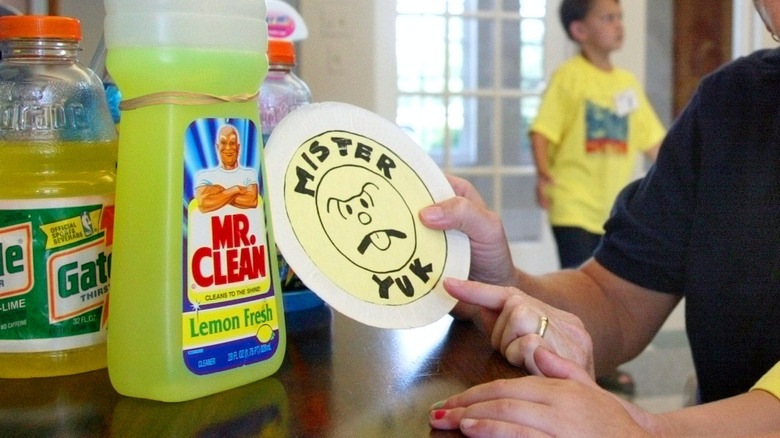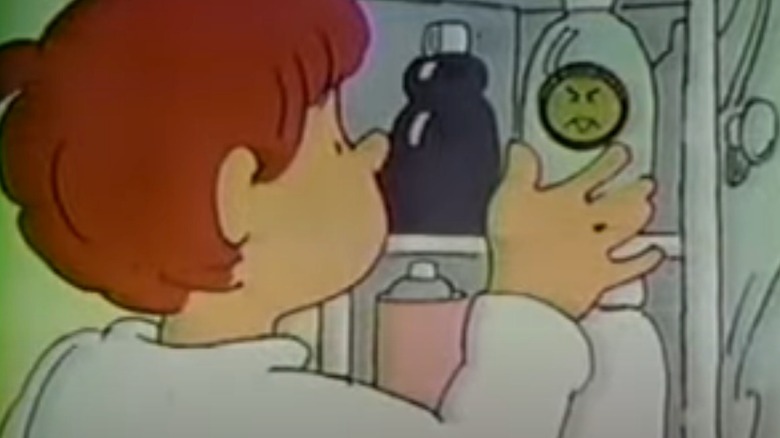What Happened To Mr. Yuk, The Poison Control Icon?
For Gen X kids in particular, Mr. Yuk stickers are instantly recognizable — a sickening fluorescent green frowning face, its tongue extended with a disgusted expression, and the 1-800 National Poison Control Center phone number often underneath. Less common now than they were in the past, Mr. Yuk stickers are still sometimes used today, warning children to stay away from potentially poisonous substances. But since he was introduced in the 1970s, Mr. Yuk's popularity has declined because some studies have shown he's less effective than experts hoped he might be.
Dr. Richard Moriarty of Pittsburgh, Pennsylvania conceived of and developed Mr. Yuk in 1971 and focus-grouped the design with children 5 and under. Researchers found Mr. Yuk's queasy expression effectively communicated danger to kids better than the traditional skull and crossbones. According to the Carnegie Museum of Natural History, one child saw the design and called it "yukky." As Moriarty told the Pittsburgh Post-Gazette, "Mr. Yuk will be easier to relate with than the skull and crossbones because the concept of death is not easy to understand but getting sick is."
Mr. Yuk had his own Super Bowl ad
Dr. Richard Moriarty's research found Pittsburgh children associated the skull and crossbones with the Pittsburgh Pirates baseball team logo. To develop something more useful, he tried three faces: angry, dead, and sick-looking. He found that when paired with a sour-green hue, many children reacted adversely to the sick face in particular — precisely what Moriarty and his team wanted. "The skull and crossbones was designed by adults for adults," Moriarty said (via the Post-Gazette). "Mr. Yuk is actually the first symbol specifically designed for kids."
With Mr. Yuk's name, look, and design settled, free Mr. Yuk stickers were introduced in 1972, and when a Mr. Yuk commercial aired during Super Bowl IX in 1975 their popularity skyrocketed. Mr. Yuk even had his own theme song (hear it in a Mr. Yuk ad, above). By the time calendars reached 1980, 50 million Mr. Yuk stickers were distributed, and more than 50 major poison control centers adopted the program across the United States, per ABC27 and Carnegie Museum of Natural History.
He didn't work as well as some had hoped
Beginning in the 1980s, studies looked at how well Mr. Yuk kept kids safe, and the results were mixed. Subsequent research has shown he may actually attract some kids rather than repel them. As a result, Mr. Yuk was recommended less as an ironclad "deterrent" for children and more as an "educational tool," according to the Journal of Pediatric Psychology. The news wasn't all bad: A 2011 Consumer Product Safety Commission study showed pediatric poisoning deaths dropped 84% between 1972 and 2008, Mr. Yuk's heyday. Mr. Yuk can't take all the credit, though — child-resistant caps were also mandated in that era.
In the end, Mr. Yuk was dropped by some poison control centers, but he never completely went away. He's still used on a Pittsburgh Poison Center Facebook page, and Mr. Yuk stickers are still distributed for free via PennState Extension. In 2016, Mr. Yuk was considered to warn children about marijuana products after they were legalized in Washington, but the state's poison control center chose a red open-palm sticker that read "Not for Kids" instead (via Reason).

